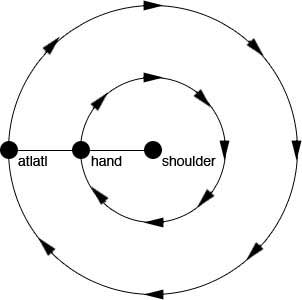|
UNIT: Math 10 - Linear Equations and Inequalities; Science 10 -
Physical Science: Motion in Our World; Science 10 - Life Science: Sustainability of Ecosystems; Native Studies 10-Economies: Aboriginal Perspectives
THEME: Human Face of Mathematics - Mathematics in Aboriginal Culture
EQUIPMENT
- atlatl and dart
- pylon (or other easily seen target that cannot damage or be damaged by the dart)
- measuring tape
- coloured tape
- distance and speed chart
- stop watch
- calculator
- computers with a spreadsheet program
- Internet
PREREQUISITE KNOWLEDGE:
Math 10
Linear Equations and Inequalities
- To solve a formula for an indicated variable.
- Calculate velocity
Science 10
Physical Science: Motion in Our World
- Categorize the motion of everyday objects as uniform and non-uniform.
- Operationally define uniform and non-uniform motion.
- Discuss the role of “frame of reference” in determining whether an object is in motion.
LEARNING OUTCOMES:
Science 10
Physical Science: Motion in Our World
- Observe and describe the motion of everyday objects qualitatively using personal words and phrases.
Life Science: Sustainability of Ecosystems
- Explore cultural perspectives on sustainability
- Investigate human impact on ecosystems
Native Studies 10
Economies: Aboriginal Perspectives
- Analyze how Aboriginal economies were environmentally responsible.
Introductory Activity modified from Poverty Point Expeditions, by Debbie Buco, Louisiana Division of Archaeology, Activity Booklets
Choose 3 students to simulate the rotation of the hand and the atlatl around the shoulder joint. One person will pretend to be the hand and observe how fast the spear would travel if the hand threw it. Another group member will pretend to be the atlatl and observe how fast the spear would travel if the atlatl threw it.
Measure and cut a piece of string or rope which is four feet long. Place a mark in the middle of the string, two feet from both ends. The "shoulder joint" member will kneel down while holding the tip of the string stationary on top of their head. The "hand" person will hold the string securely at the two foot measurement, and the "atlatl" person will hold the end of the string (four feet from the "shoulder joint" person.)

The "atlatl" person must keep the string taut at all times while walking in a circle around the "shoulder joint" person. The "hand" person must keep pace with the "atlatl" person. Have the class determine who is running faster.
This demonstrates how throwing with an atlatl increases the speed of the dart as it is thrown. A dart which is thrown from an atlatl the length of your arm would travel approximately twice as fast as a dart thrown by the hand. For an even more vivid simulation, increase the length of the radius for the atlatl to about six feet. The larger the radius, the faster the "atlatl" will travel.
Teacher Set Up
- Using the coloured tape, mark off a throw line. Make sure there is ample space for students to throw the dart.
- About 10 metres from the throw line, place a pylon so the students have something to aim at. You may have to adjust target placement depending on your students.
Student Instructions
Background Information
- Research the weapons of the Aboriginal people pre and post contact.
- Describe the effect on the animal population and Aboriginal way of life when each weapon was introduced.
Part 1: Maximum Distance & Speed
- Decide on 3 or 4 students from the class to throw. Record the distance and time traveled for each length.
- From the line, each person throws the dart 5 times without using the atlatl, aiming at the pylon.
- Measure each throw from the line to see how far the dart traveled.
- Record the distance and time the dart traveled for each person.
- Repeat steps 2-4 with the atlatl.
Part 2: Physical Characteristics of Thrower
- Measure the height of each thrower and their arm length.
Part 3: Motion of the Atlatl and Dart
- While the dart is being thrown, observe the thrower from the side.
- Through the course of all of the trials, describe and sketch the motion of the thrower and the path of dart for the farthest and most accurate throws. (Bare in mind that the farthest throws may not be the most accurate).
- Investigate why this motion is the optimal.
Data Analysis
- Calculate the speed for each throw
- Determine which the maximum distance with and without the atlatl for each thrower.
- Determine the maximum speed (v=d/t) for each thrower
- Compare the results with and without atlatl using a spreadsheet and choosing an appropriate graph type
- Determine whether the dart went farther and faster with or without the use of the atlatl. Think of some ideas why.
- As a group answer the following questions:
- How does the physical attributes of the person throwing the atlatl effect the experiment?
- What other factors would effect the experiment?
- How could the results differ for different people throwing the dart?
Closure
- As a class, form conjectures as why different throwers may have had different results and how the experiment could be changed to have more accurate results.
- Discuss the following quote:
The atlatl and dart is truly the natural weapon system of the human race. When humans used the atlatl, we were in balance with nature. We didn’t take more from the environment than what the environment could replace itself. -Dr William Robert Perkins, Atlatl researcher
Lessons for Beginner Atlatl Users - Grade 10 PDF
Alternative Math 10 Lesson - Math 7
Lessons for Atlatl Users with Some Experience - Grade 10
Atlatl Home Page
|

